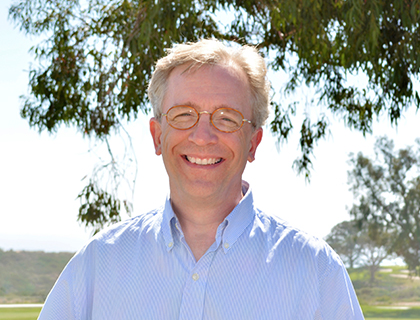Scott Henderson Joins TSRI as Director of Microscopy Core Facility
By Bonnie Ward

Scott Henderson, who has been directing microscopy core facilities for nearly 25 years, loves to talk about how such facilities help scientists explore essential cellular functions and gain a better understanding of the mechanisms associated with disease.
“It used to be that microscopes were used primarily to capture static pictures,” said Henderson, the new director of TSRI’s Microscopy Core Facility. “But in the past 30 years or so, there’s been a renaissance in microscopy, with concurrent advances in the development of hardware (optics, detectors, lasers, etc.) and analytical software, as well as chemical reporters and biological probes, which now allow us to look quantitatively at dynamic cellular activities in multiple dimensions with greater sensitivity and greater spatial and temporal resolution.”
He said these advances enable researchers to investigate how molecules behave in their natural environment, which can provide important insights into essential cellular processes.
TSRI’s Microscopy Core Facility offers electron microscopy (TEM and SEM), confocal microscopy (both laser scanning and spinning disc) multi-photon, total internal reflection fluorescence (TIRF) and ‘super-resolution’ stochastic optical reconstruction microscopy (STORM) along with a full range of services including: consultation, experimental design, sample preparation, assistance with imaging & image analysis, user training, technical support, and assistance with research grant applications.
As the facility’s director, Henderson’s duties include hands on scientific collaboration as well as administrative tasks. One of his roles is to help researchers determine the best imaging tools needed for exploring their areas of interest. “A scientist will tell me about a project and what they are attempting to determine and one of my jobs is to suggest ways they might go about it,” said Henderson, a professor in TSRI’s Department of Molecular Medicine. “When you run a core, given the number of investigators and the diversity of research projects, there is something new every day. You’re constantly shifting gears and changing directions, which keeps things extremely interesting.”
Henderson comes to TSRI from Virginia Commonwealth University in Richmond, where he was director of the VCU Microscopy Facility and an Associate Professor in the Department of Anatomy and Neurobiology for 13 years. Prior to that time, he was a member of the faculty at Mount Sinai School of Medicine in New York, where he directed the microscopy shared resource facility. He earned his PhD at the University of Western Ontario in London, Ontario, Canada and subsequently did postdoctoral training at Cold Spring Harbor Laboratory in New York.
He said TSRI’s great scientific reputation attracted him to the new position. “The quality of work done here made this move very attractive,” he said.
In discussing the core’s activities, Henderson said multi-dimensional imaging and image analysis represents a big part of their services. “For instance, we can quantify rates of cell migration or changes in expression of various proteins of interest or analyze molecular movements within cells or molecular interactions within subcellular compartments. This is often done by tagging cells with fluorescent proteins or adding fluorescent dyes to the cells and imaging the cells in a living state,” said Henderson. Such observations can give scientists important information on myriad issues, such as the effectiveness of a new therapy.
Henderson readily acknowledges that microscopy is only one of many tools used by researchers to explore the body’s cellular landscape. But he notes that it offers a key advantage – spatial context. “Oftentimes, you look at molecular interactions in a tube,” said Henderson.
“While that can provide an abundance of information, what it lacks is spatial context. Microscopy allows you to see what a molecule is doing within the cell, or what a cell is doing within a tissue and can provide a spatial and temporal framework for these activities. A molecule’s function is often dependent upon its location within the cell. Having a better appreciation of a molecule’s function or a cell’s behavior, within a spatial context provided by microscopy, helps researchers to better understand basic cellular functions as well as potentially find better ways to combat disease.”
Send comments to: press[at]scripps.edu













